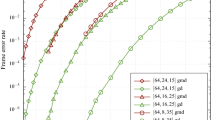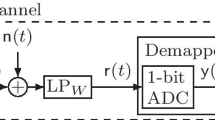Abstract
In this work, we consider the pairwise error probability (PEP) of a linear programming (LP) decoder for a general binary linear code as formulated by Feldman et al. (IEEE Trans. Inf. Theory, March 2005) on a quantized additive white Gaussian noise (AWGN) channel. With a quantized AWGN (QAWGN) channel, we mean a channel where we first compute log-likelihood ratios as for an AWGN channel and then quantize them. Let H be a parity-check matrix of a binary linear code and consider LP decoding based on H. The output of the LP decoder is always a pseudo-codeword, of some pseudo-weight, where the definition of pseudo-weight is specific to the underlying channel model. In this work, we give a definition of pseudo-weight for a QAWGN channel based on an asymptotic (high signal-to-noise ratio) analysis of the PEP. Note that with maximum-likelihood decoding, the parameters of the quantization scheme, i.e., the quantization levels and the corresponding quantization region thresholds, that minimize the PEP of wrongly decoding to a non-zero codeword c when the all-zero codeword is transmitted is independent of the specific codeword c. However, this is not the case with LP decoding based on a parity-check matrix H, which means that the quantization scheme needs to be optimized for the given H. As a case study, we consider the well-known (3,5)-regular (155,64,20) Tanner code and estimate its minimum QAWGN pseudo-weight with 3 and 5 levels of quantization, in which the quantization scheme is optimized to maximize the minimum QAWGN pseudo-weight.
Preview
Unable to display preview. Download preview PDF.
Similar content being viewed by others
References
Berrou, C., Glavieux, A., Thitimajshima, P.: Near Shannon limit error-correcting coding and decoding: Turbo-codes. In: Proc. IEEE Int. Conf. Commun. (ICC), Geneva, Switzerland, pp. 1064–1070 (May 1993)
Gallager, R.G.: Low-density parity-check codes. IRE Trans. Inf. Theory 8(1), 21–28 (1962)
MacKay, D.J.C.: Good error-correcting codes based on very sparse matrices. IEEE Trans. Inf. Theory 45(2), 399–431 (1999)
Di, C., Proietti, D., Telatar, I.E., Richardson, T.J., Urbanke, R.L.: Finite-length analysis of low-density parity-check codes on the binary erasure channel. IEEE Trans. Inf. Theory 48(6), 1570–1579 (2002)
Schwartz, M., Vardy, A.: On the stopping distance and the stopping redundancy of codes. IEEE Trans. Inf. Theory 52(3), 922–932 (2006)
Feldman, J., Wainwright, M.J., Karger, D.R.: Using linear programming to decode binary linear codes. IEEE Trans. Inf. Theory 51(3), 954–972 (2005)
Vontobel, P.O., Koetter, R.: Graph-cover decoding and finite-length analysis of message-passing iterative decoding of LDPC codes. IEEE Trans. Inf. Theory (to appear), http://arxiv.org/abs/cs.IT/0512078/
Forney Jr., G.D., Koetter, R., Kschischang, F.R., Reznik, A.: On the effective weights of pseudocodewords for codes defined on graphs with cycles. In: Marcus, B., Rosenthal, J. (eds.) Codes, Systems, and Graphical Models. IMA Vol. Math. Appl., vol. 123, pp. 101–112. Springer, Heidelberg (2001)
Rosnes, E.: On the pairwise error probability of linear programming decoding on independent Rayleigh flat-fading channels. IEEE Trans. Inf. Theory 55(7), 2942–2955 (2009)
Feldman, J., Koetter, R., Vontobel, P.O.: The benefit of thresholding in LP decoding of LDPC codes. In: Proc. IEEE Int. Symp. Inf. Theory (ISIT), Adelaide, SA, Australia, pp. 307–311 (September 2005)
Kelley, C.A., Sridhara, D.: Pseudocodewords of Tanner graphs. IEEE Trans. Inf. Theory 53(11), 4013–4038 (2007)
Rosnes, E.: On the connection between finite graph covers, pseudo-codewords, and linear programming decoding of turbo codes. In: Proc. 4th Int. Symp. Turbo Codes & Related Topics, Munich, Germany (April 2006)
Feldman, J.: Decoding Error-Correcting Codes via Linear Programming. PhD thesis, Dept. of Electrical Engineering and Computer Science, Massachusetts Institute of Technology (MIT), Cambridge, MA (2003)
Tanner, R.M., Sridhara, D., Fuja, T.: A class of group-structured LDPC codes. In: Proc. Int. Symp. Commun. Theory and Appl (ISCTA), Ambleside, UK (July 2001)
Chilappagari, S.K., Chertkov, M., Vasic, B.: Provably efficient instanton search algorithm for LP decoding of LDPC codes over the BSC. IEEE Trans. Inf. Theory (submitted for publication) (2008), http://arxiv.org/abs/0808.2515/
Chertkov, M., Stepanov, M.G.: An efficient pseudocodeword search algorithm for linear programming decoding of LDPC codes. IEEE Trans. Inf. Theory 54(4), 1514–1520 (2008)
Rosnes, E., Ytrehus, Ø.: An efficient algorithm to find all small-size stopping sets of low-density parity-check matrices. IEEE Trans. Inf. Theory 55(9), 4167–4178 (2009)
Author information
Authors and Affiliations
Editor information
Editors and Affiliations
Rights and permissions
Copyright information
© 2009 Springer-Verlag Berlin Heidelberg
About this paper
Cite this paper
Rosnes, E. (2009). On Linear Programming Decoding on a Quantized Additive White Gaussian Noise Channel. In: Parker, M.G. (eds) Cryptography and Coding. IMACC 2009. Lecture Notes in Computer Science, vol 5921. Springer, Berlin, Heidelberg. https://doi.org/10.1007/978-3-642-10868-6_2
Download citation
DOI: https://doi.org/10.1007/978-3-642-10868-6_2
Publisher Name: Springer, Berlin, Heidelberg
Print ISBN: 978-3-642-10867-9
Online ISBN: 978-3-642-10868-6
eBook Packages: Computer ScienceComputer Science (R0)




